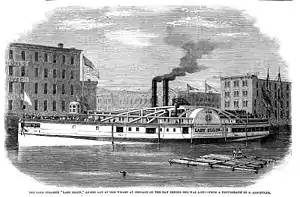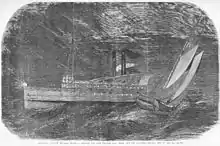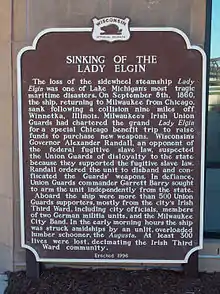PS Lady Elgin
The PS Lady Elgin was a wooden-hulled sidewheel steamship that sank in Lake Michigan off the fledgling town of Port Clinton, Illinois, whose geography is now divided between Highland Park and Highwood, Illinois, after she was rammed in a gale by the schooner Augusta in the early hours of September 8, 1860. The passenger manifest was lost with the collision, but the sinking of Lady Elgin resulted in the loss of about 300 lives[2] in what was called "one of the greatest marine horrors on record". Four years after the disaster, a new rule required sailing vessels to carry running lights. The Lady Elgin disaster remains the greatest loss of life on open water in the history of the Great Lakes.[3]
 Lady Elgin at Dock September 7, 1860
| |
| History | |
|---|---|
| Name: | Lady Elgin |
| Operator: | Gurdon Saltonstall Hubbard |
| Builder: |
|
| Completed: | 1851 |
| Fate: | Sunk in collision with schooner Augusta of Oswego September 8, 1860 |
| Notes: | First enrollment issued at Buffalo, New York November 5, 1851 |
| General characteristics | |
| Class and type: | Sidewheel steamer - passengers and package freight |
| Tonnage: | 1037.70 gross[1] |
| Length: | 252 ft (77 m)[1] |
| Beam: | 32.66 ft (9.95 m)[1] |
| Height: | 13 ft (4.0 m)[1] |
| Notes: | Wood hull vessel |
In 1994, a process began to list the shipwreck on the National Register of Historic Places. After it was determined to be eligible for listing in 1999, the process ended after an objection by the owner, so the shipwreck is not listed on the Register.[4]
Career

Lady Elgin was built in 1851 in Buffalo, New York, at a cost of $95,000. She was named after the wife of Lord Elgin, Canada's Governor General from 1847 to 1854.[5] During her time, the wooden-hulled sidewheeler was one of the most elegantly appointed passenger ships plying the Great Lakes. Rated a first-class steamer, she was a favorite with the traveling public. Early in her career she ran between Buffalo and Chicago, then later between Chicago and Collingwood, Ontario. For many of her later seasons, she plied the route between Chicago and other Lake Michigan ports and Lake Superior.[6]
During Lady Elgin's career she was involved in numerous accidents. She sank and was repaired in 1854 after striking a rock at Manitowoc, Wisconsin. In 1855, she was towed to Chicago after an accident to her machinery. In 1857, she was damaged by fire. In June 1858, she struck a reef at Copper Harbor, Michigan. In August 1858, she was stranded on Au Sable Point Reef in Lake Superior. In October 1859, she was towed to Marquette, Michigan after breaking her crossbeam. In November 1859, she was towed again when her crank pin broke near Point Iroquois, Michigan.[7] Her final blow came in 1860 when she was rammed by the wooden schooner Augusta ten miles from shore. In 1899, Great Lakes historian J.B. Mansfield called Lady Elgin's sinking "one of the greatest marine horrors on record".[6]
Final voyage

On the night of September 6, 1860 Lady Elgin left Milwaukee, Wisconsin, from the Dooley, Martin, Dousman, and Company Dock, for Chicago, carrying members of Milwaukee's Union Guard to hear a campaign speech by Stephen A. Douglas, Abraham Lincoln's opponent, although there is no clear historical evidence that Douglas actually appeared. Three hundred men and women spent the day of September 7 listening to political speeches followed by an evening of entertainment by a German brass band on board Lady Elgin.[5] On the return trip that night, the brightly lit Lady Elgin was steaming through Lake Michigan against gale force winds when she was rammed by the schooner Augusta of Oswego. Augusta was sailing using only a single white light, mounted on a five-foot Samson on the bow, and did not attempt, or was unable, to turn to avoid the collision in the gale.[8] On the morning of the collision (September 8) at 2:30 am, Augusta rammed the port side of Lady Elgin, damaging her own bowsprit and headgear, while holing the latter ship below the waterline.[8]
Concerned that she was damaged and believing Lady Elgin had got safely away, Augusta made for Chicago. Aboard Lady Elgin, Captain Wilson ordered that cattle and cargo be thrown overboard to lighten the load and raise the gaping hole in Lady Elgin's port side above water level while the steward was down in the coal bunker trying to stop the leak with mattresses.[6][9] Captain Wilson ordered a lifeboat lowered on the starboard side to check the extent of the damage but it never regained the steamer. Within twenty minutes, Lady Elgin broke apart, and all but the bow section rapidly sank. The night was lit up at intervals by flashes of lightning showing the scattered wreckage.[6]
The life preservers, 2 in (5.1 cm) hardwood planks, 5 ft (1.5 m) long and 18 in (46 cm) wide, were never used.[5] Two boats with a total of 18 persons reached shore. In addition, fourteen people were saved on a large raft and many others on parts of the wreckage. Over 300 lives were lost and 98 saved.[6] The drummer of the German band, Charles Beverung, saved himself by using his large bass drum as a life preserver.[5] Survivors reported the heroic efforts of Captain Wilson to save about 300 persons collected on a raft.[6] When day broke, between 350 and 400 passengers and crew were drifting in stormy waters, holding on to anything they could, many only to be pulled under by breakers near shore.
Students from Northwestern University and Garrett Biblical Institute were watching the shore on the morning of September 8, looking for survivors. One of the students, Edward Spencer, is credited with rescuing 17 passengers over the course of six hours. He sustained injuries during his rescue efforts that left him an invalid for the rest of his life. A plaque in his honor was first placed in the Northwestern University Gymnasium, and is now housed in the Northwestern University Library.[10][11]
About 300 people died in the sinking,[2] including Captain Wilson, who was lost trying to save two women when he was caught by the surf and forced into the rocks.[10] Most were from Milwaukee with the majority of those from the Irish communities, including nearly all of Milwaukee's Irish Union Guard.[12] So many Irish-American political operatives died that day that the disaster has been credited with transferring the balance of political power in Milwaukee "from the Irish to the Germans".[13] It is said that more than 1000 children were orphaned by the tragedy, however research shows that there were fewer than 40 children orphaned.[14] The Lady Elgin disaster remains the greatest loss of life on open water in the history of the Great Lakes.[3]
Memorials

A Wisconsin historical marker in the historic third ward in Milwaukee commemorates the tragedy. Calvary Cemetery in Milwaukee has a monument dedicated to the Lady Elgin disaster and the many lost in the tragedy who are buried there. For many years in central Canada the memorial song "Lost on the Lady Elgin" was sung at family gatherings and social occasions.[5] The Milwaukee Irish Heritage and Cultural Center has spearheaded a $200,000 project for a mammoth, two-story bronze memorial statue for the Lady Elgin disaster.[15]
Maritime rulings
Following the sinking, Lady Elgin's owner, Gurdon Saltonstall Hubbard, received a $12,000 payment from his insurance company, but neither he nor the insurance company accepted abandonment of the ship. The captain of Augusta, Darius Malott, was arrested and tried in Chicago, but found not guilty of navigational negligence. A coroner's jury declared his second-mate, Mr. Budge, to be incompetent, and his crew to be of principal blame.[16] However, Professor Mason and Lieutenant Bartlett asserted that a principal cause of the collision was the lack of a $15 lantern on the Augusta - see Polytechnic Association of the American Institute, Scientific American, New Series, Vol 3, Issue 14, page 214.(September 29, 1860). Steamboat historian Peter Charlebois noted that, after the investigation, Captain Malott and Lady Elgin's crew and owners were absolved of any blame. He reported:
The judgement was based on a law that not only gave sail the right of way over steam, but did not require sailing vessels to carry running lights. Apparently Augusta had sighted the passenger steamer twenty minutes before the collision but in the rain had misjudged the distance between them. Four years after the disaster, in 1864, a new ruling was made requiring sailing vessels to carry running lights. Since there were still nearly 1,900 ships under sail by 1870 the regulations were long overdue.[5]
Wreck
The wreck of Lady Elgin was discovered in 1989 off Highwood, Illinois by Harry Zych. Zych was awarded ownership in 1999 after a protracted legal battle.[17] The wreck, consisting of four main debris fields lying in 50 and 60 feet (15 and 18 m) of water, has been stripped of artifacts through the years. Divers must obtain permission from Zych and Lady Elgin Foundation,[18] and are expected to observe the preservation laws governing historic sites.[19] The wreck site has been cataloged by the Underwater Archaeological Society of Chicago.
References
- "Lady Elgin". Historical Collection of the Great Lakes. Bowling Green State University. 2003. Retrieved February 2, 2009.
- Journal of Board of Supervising Inspectors, Vol 1, page 43, National Archives Record Group 41
- "The Wreck of the Lady Elgin: 150th Anniversary Commemorative Event". Discovery World at Pier Wisconsin. Retrieved October 24, 2010.
- "National Register Information System". National Register of Historic Places. National Park Service. July 9, 2010.
- Charlebois, Peter (1978). Sternwheelers and Sidewheelers. Toronto: NC Press Limited. p. 10. ISBN 0-919600-72-7.
- "History of the Great Lakes". rootsweb.ancestry.com/~migenweb/ Publisher, Chicago: J.H. Beers & Co, 1899. Reproduced by Michigan Genealogy on the Web. Retrieved February 22, 2009.
- "Lady Elgin". Alpena County Public Library. Archived from the original on July 26, 2011. Retrieved February 22, 2009.
- Boyer, Dwight (1971). True Tales of the Great Lakes. Cleveland, OH: Freshwater Press Inc. pp. 177–208. ISBN 0-912514-48-5.
- "The Lady Elgin Disaster; Coroner'S Inquest at Chicago Testimony of Persons On Board the Two Vessels" (PDF). The New York Times. September 13, 1860. Retrieved February 22, 2009.
- "Lady Elgin". ship-wrecks.net. Retrieved March 7, 2015.
- "Wrecked: The story of Northwestern's first "varsity sport"". northbynorthwestern.com. Retrieved March 7, 2015.
- "Archived copy". Archived from the original on July 28, 2011. Retrieved April 18, 2010.CS1 maint: archived copy as title (link)
- Zych v. Wrecked Vessel believed to be Lady Elgin, 960 F.2d 665, 667 (7th Cir. 1992).
- "Lost on the Lady Elgin", Valerie van Heest, 2010.
- "Lady Elgin Memorial Statue". Milwaukee Wisconsin Journal Sentinel. Retrieved February 22, 2009.
- New York Times. September 25, 1860. Missing or empty
|title=(help) - Zych v. Wrecked Vessel believed to be Lady Elgin, 960 F.2d 665 (7th Cir. 1992), cert. denied, 1994; People ex rel. Illinois Historic Preservation Agency v. Zych, 186 Ill. 2d 267, 710 N.E.2d 820 (1999).
- Baillod, Brendon. "The Wreck of the Steamer Lady Elgin". Ship-wreck.com. Archived from the original on July 24, 2011. Retrieved February 2, 2009.
- "National Register of Historic Places, Lake County, Illinois". National Register of Historic Places. Retrieved February 22, 2009.
External links
| Wikimedia Commons has media related to Lady Elgin (ship, 1851). |
- The Great Lakes Shipwreck File
- New York Times account of the sinking
- Descendant of Lady Elgin victims dives to wreck site in Illinois
